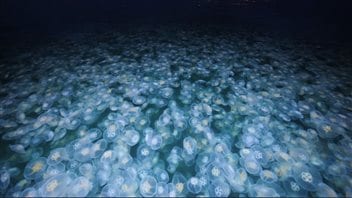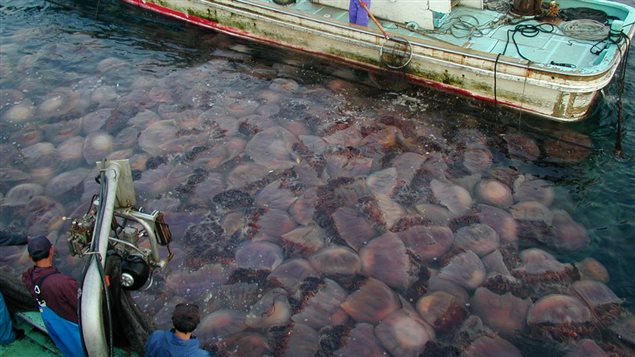It’s not exactly an “alarm” but scientists are concerned about the increasing numbers of jellyfish in the world’s oceans.
Lucas Brotz has been studying jellyfish and produced a report in 2012 indicating that numbers of “jellies” were on the rise. He is a PhD student with the Sea Around Us project at the University of British Columbia Fisheries Centre.
ListenJellyfish are ancient survivors. Though they’ve been around for hundreds of millions of years, there’s still much left to learn about them.

One thing for sure is that with the increased numbers come increased problems. Far more people die each year from jellyfish stings than from shark attacks. Even though most species stings are not fatal, thousands of swimmers can suffer mild to serious complications from stings and the numbers are likely to increase.
“Jellies” are also causing serious damage to power plants and water desalination operations, as well as to fishing operations, with very high costs involved.
Brotz points out that jellyfish have always been part of the ecosystem but that human interference is upsetting natural balance.
He says a number of factors are likely involved including overfishing which at one and the same time remove both predators, and competition for food sources.
He notes that the increasing areas of low oxygen regions in the oceans do not hinder jellies to the same extent as other marine species, again giving them a potentional advantage.

The increasing number of man-made structures in the oceans, piers, docks, oil platforms and so on gives jellyfish polyps a vast number of new areas to grow that they wouldn’t ordinarily have in nature.
Ocean warming is an unknown says Brotz, although it does tend to favour reproduction in many marine species. He notes that jelly blooms are now occurring in areas where they haven’t traditionally been seen, and that where they are known to occur, they are occurring earlier and staying longer.
He says it’s difficult and costly for scientists to keep on top of blooms around the world and notes the public can be a great help
The public can report jellyfish blooms through the website JellyWatch.org,







For reasons beyond our control, and for an undetermined period of time, our comment section is now closed. However, our social networks remain open to your contributions.